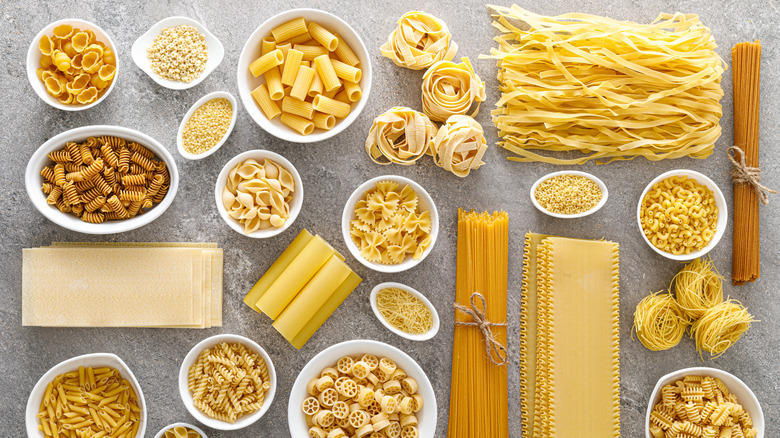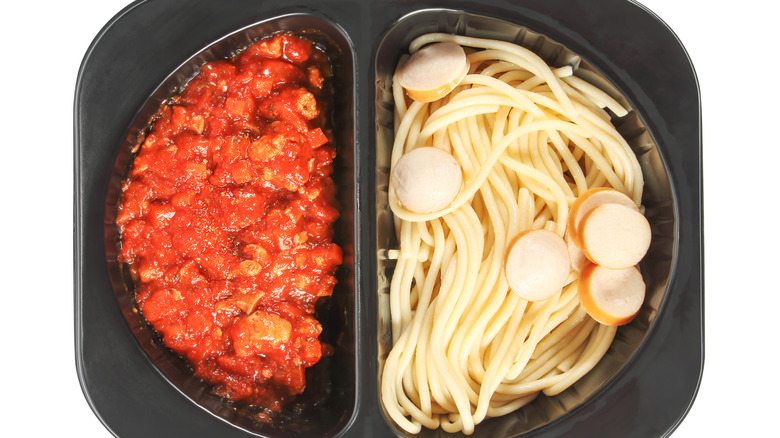How To Know If Pasta Has Gone Bad
It was like a love affair, still burning strong, that tripped upon some plot changes that only stoked the smoldering embers. For people who wax poetic about food, this is no overstatement about Americans' love affair with pasta. Consider Italian food proved to be the worldwide favorite among more than 25,000 people in 24 countries who were surveyed by YouGov in 2019. Italian food, which its pasta and pizza, turned out to be the most popular of all.
This was before the pandemic struck and before people realized that pasta was precisely what they needed during lockdown: food that was economical, easy to prepare, and versatile. Besides, pasta was the quintessential comfort food during a troubling time. The numbers proved it: worldwide pasta consumption soared to 17 million tons in 2020 (the first year of the pandemic), beating the record-setting 2019 by 1 million tons, Magazine BBM says. Demand for pasta remained high in 2021, with the United States standing tall as the world's dominant pasta importer.
If you can, try to sidestep debate on which type of pasta is America's favorite. "Top 10" lists often contain the usual suspects. And one rule defies pasta shape: cooked pasta dishes should last between three and five days in the refrigerator, Healthline says. This means it's crucial to know when pasta has gone bad.
Rely on sight and smell
Common sense serves most people well in assuming that they should distinguish between dry and cooked pasta. Dry pasta, sold in boxes, is unlikely to go bad because bacteria won't grow there, PureWow says. This is partly why people rushed to stock up on pasta during the pandemic and grocery store shelves quickly exposed gaping holes in pasta aisles, Magazine BBM says. Still, it's worth noting that many boxed pasta brands feature expiration or "sell-by" dates, which suggests that the quality and flavor of pasta will diminish over time. This is a minor inconvenience compared to the possibility of contracting food poisoning from pasta that has spoiled.
Signs of spoilage can be easy to spot on some types of food, especially when there is a color contrast between the food and the growing bacteria. But this contrast isn't always visible on pasta, especially early on. This is why pasta that has been refrigerated for a few days deserves extra scrutiny. Bad pasta may be changing color and feature moldy streaks of white, gray, or green. A thin layer of clear, slimy film is another probable warning sign that cooked pasta should be thrown away; there is no saving it.
If looks alone don't alert you to trouble, then take a whiff of the pasta. Your sense of sight and smell should be "the most reliable instruments" of judging spoiled food, Eat by Date says.
Good storage habits matter
Obviously, your goal is to identify bad pasta before you ingest it and develop gastrointestinal issues like upset stomach, cramps, diarrhea, or vomiting, Healthline says. A food poisoning episode makes people eager to avoid a repeat, and it may come down to learning some simple safe-storage techniques. You may know that cooked food should be placed in the refrigerator within two hours to limit the growth of bacteria, and after only one hour if the room temperature is 90 degrees or above, the U.S. Food & Drug Administration says.
The standard two-hour rule may be even more pressing with pasta, which was cooked in water and so contains perhaps even more moisture than other leftovers in your refrigerator. To restrain the moisture from cooked pasta, store it not only in airtight but also shallow containers, Healthline says.
It's also worth checking the temperature inside your refrigerator. It should be 40 degrees or less, which you can verify with a refrigerator thermometer, sold at home improvement stores. The FDA issues a stark warning in saying that spoiled food can be sneaky; it doesn't always look, smell, or taste bad. Refrigeration can stop bacteria in its tracks, and maybe give you another day or two to savor the pasta you love most.


